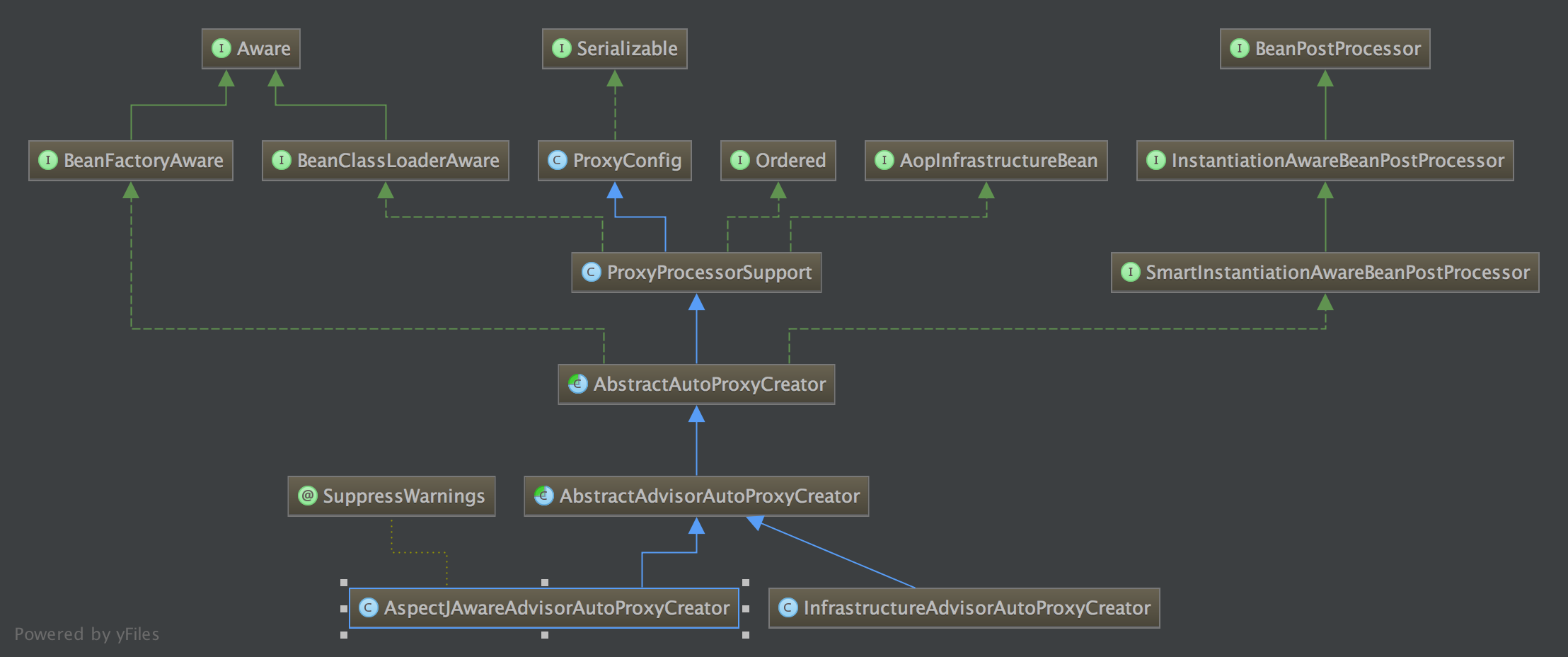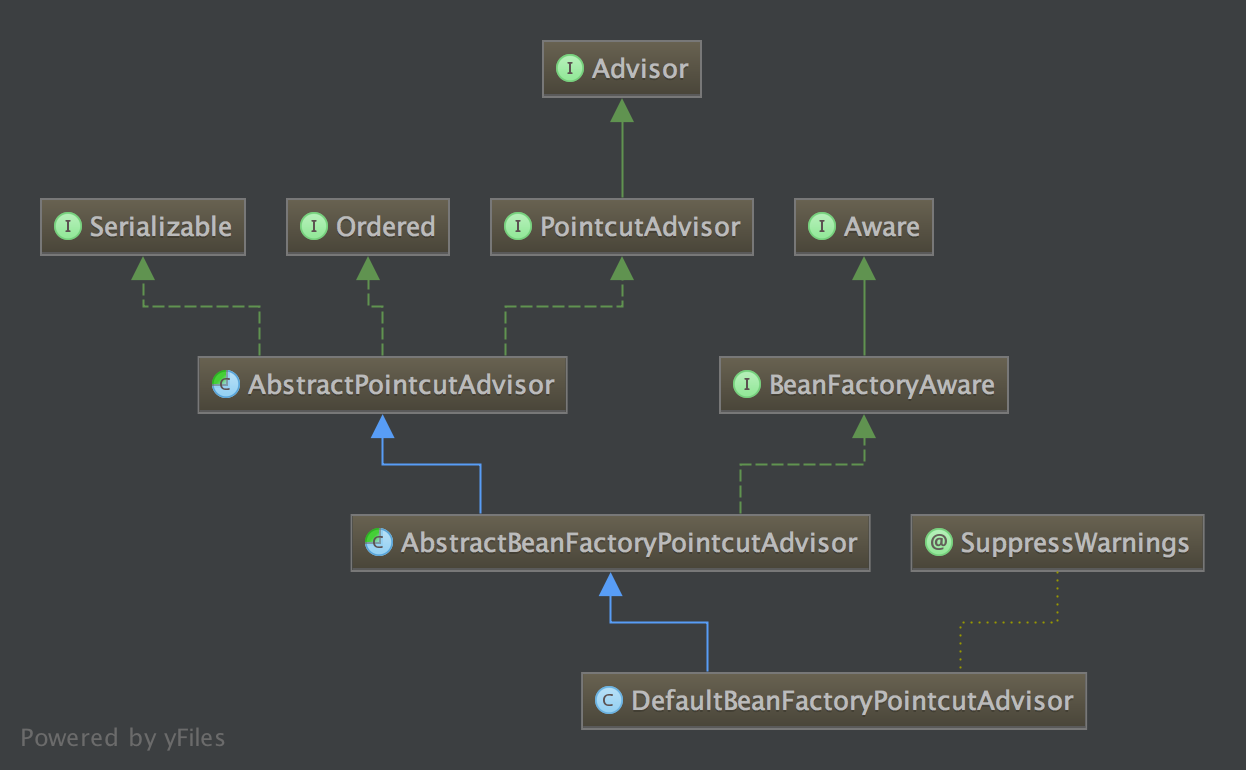1 概述
1.1 示例
最基本的使用,在创建了业务接口和实现类后,通过配置<aop:config>....</aop:config>标签来指定<aop:pointcut和<aop:advisor。示例如下:
1.1.1 创建接口及实现类
接口:
public interface MockService {
public String hello(String s);
}
实现类:
public class MockServiceImpl implements MockService {
@Override
public String hello(String s) {
System.out.println("execute hello");
return s;
}
}
1.1.2 实现方法拦截
实现接口org.aopalliance.intercept.MethodInterceptor
public class CustomInterceptor implements MethodInterceptor {
@Override
public Object invoke(MethodInvocation invocation) throws Throwable {
System.out.println("CustomInterceptor before");
Object result = invocation.proceed();
System.out.println("CustomInterceptor after");
return result;
}
}
1.1.3 配置xml
创建aop.xml,放在resources目录下:
<?xml version="1.0" encoding="UTF-8"?>
<beans xmlns="http://www.springframework.org/schema/beans"
xmlns:aop="http://www.springframework.org/schema/aop"
xmlns:xsi="http://www.w3.org/2001/XMLSchema-instance"
xsi:schemaLocation="http://www.springframework.org/schema/beans
http://www.springframework.org/schema/beans/spring-beans-2.5.xsd
http://www.springframework.org/schema/aop
http://www.springframework.org/schema/aop/spring-aop-2.5.xsd"
default-lazy-init="false" default-autowire="byName">
<!-- 实现来org.aopalliance.intercept.MethodInterceptor的拦截器 -->
<bean id="customInterceptor" class="com.xxx.yyy.CustomInterceptor"/>
<bean id="mockService" class="com.xxx.yyy.MockServiceImpl"/>
<aop:config proxy-target-class="true">
<aop:pointcut id="interceptorPointCuts" expression="execution(* com.xxx.yyy..*.*(..))"/>
<aop:advisor advice-ref="customInterceptor" pointcut-ref="interceptorPointCuts"/>
</aop:config>
</beans>
1.1.4 运行
public class Main {
public static void main(String[] args){
ApplicationContext context = new ClassPathXmlApplicationContext("aop.xml");
MockService mockService = (MockService) context.getBean("mockService");
mockService.hello("mock");
}
}
返回:
CustomInterceptor before
execute hello
CustomInterceptor after
1.2 AOP实现过程
Spring环境启动过程中,会调用AbstractApplicationContext.refresh(),AOP的实现流程,也就是从这里开始。
- 1 在
obtainFreshBeanFactory()执行过程中,加载aop.xml,并根据namespace找到aop对应的NamespaceHandler:AopNamespaceHandler; - 2
AopNamespaceHandler中,找到config标签对应的BeanDefinitionParser的实现对象,也就是ConfigBeanDefinitionParser; - 3 执行
ConfigBeanDefinitionParser.parse,有两个作用:- 以
AspectJAwareAdvisorAutoProxyCreator注册BeanDefinition; - 解析
pointcut,advisor等标签,并将相关对象注册为BeanDefinition。
- 以
- 4 注册BeanPostProcessor:
AspectJAwareAdvisorAutoProxyCreator是BeanPostProcessor的实现类AbstractAutoProxyCreator的子类。注册BeanPostProcessor后,AspectJAwareAdvisorAutoProxyCreator会在Spring创建bean的代理过程中调用。 - 5 创建proxy,并用advisor增强,主要有几步:
- 创建代理;
- 查找匹配的advisor;
- 增强代理。
2 AopNamespaceHandler
Spring环境的加载,需要调用AbstractApplicationContext.refresh()。
在refresh()方法中,执行ConfigurableListableBeanFactory beanFactory = obtainFreshBeanFactory();创建BeanFacotry的时候,加载并解析xml资源。
在这个过程中,会调用BeanDefinitionParserDelegate.parseCustomElement进行扩展标签的解析:
public BeanDefinition parseCustomElement(Element ele, BeanDefinition containingBd) {
// 获取namespace
String namespaceUri = getNamespaceURI(ele);
// 根据文件META-INF/spring.handlers,获取对应的NamespaceHandler
NamespaceHandler handler = this.readerContext.getNamespaceHandlerResolver().resolve(namespaceUri);
if (handler == null) {
error("Unable to locate Spring NamespaceHandler for XML schema namespace [" + namespaceUri + "]", ele);
return null;
}
// 调用NamespaceHandler.parse方法,返回BeanDefinition
return handler.parse(ele, new ParserContext(this.readerContext, this, containingBd));
}
详细过程可参考Spring自定义标签配置的源码解析与实现。
对于<aop:config/>,Spring会根据xmlns去META-INF/spring.handlers文件中查找相应的namespace解析类:
http\://www.springframework.org/schema/aop=org.springframework.aop.config.AopNamespaceHandler。
在AopNamespaceHandler中:
registerBeanDefinitionParser("config", new ConfigBeanDefinitionParser());
所以:
aopnamespace的解析类是AopNamespaceHandler<aop:config/>标签的解析类是ConfigBeanDefinitionParser,在ConfigBeanDefinitionParser中,<aop:config/>定义的各个元素被解析为BeanDefinition。
3 ConfigBeanDefinitionParser
ConfigBeanDefinitionParser实现了BeanDefinitionParser接口,在parse(Element element, ParserContext parserContext)方法中,实现了两部分功能:
- 1 向Spring环境注册一个BeanDefinition:
AspectJAwareAdvisorAutoProxyCreator; - 2 将xml配置的pointcut,advisor等解析为一系列BeanDefinition。
@Override
@Nullable
public BeanDefinition parse(Element element, ParserContext parserContext) {
CompositeComponentDefinition compositeDef =
new CompositeComponentDefinition(element.getTagName(), parserContext.extractSource(element));
parserContext.pushContainingComponent(compositeDef);
// 注册AspectJAwareAdvisorAutoProxyCreator为BeanDefinition
configureAutoProxyCreator(parserContext, element);
List<Element> childElts = DomUtils.getChildElements(element);
for (Element elt: childElts) {
String localName = parserContext.getDelegate().getLocalName(elt);
if (POINTCUT.equals(localName)) {
// 解析pointcut
parsePointcut(elt, parserContext);
}
else if (ADVISOR.equals(localName)) {
// 解析advisor
parseAdvisor(elt, parserContext);
}
else if (ASPECT.equals(localName)) {
parseAspect(elt, parserContext);
}
}
parserContext.popAndRegisterContainingComponent();
return null;
}
其中:
private static final String POINTCUT = "pointcut";
private static final String ADVISOR = "advisor";
private static final String ASPECT = "aspect";
3.1 AspectJAwareAdvisorAutoProxyCreator

3.1.1 作用
AspectJAwareAdvisorAutoProxyCreator是AbstractAutoProxyCreator的子类;- AbstractAutoProxyCreator实现了接口
BeanPostProcessor; - AbstractAutoProxyCreator在
postProcessAfterInitialization的实现中,调用wrapIfNecessary进行bean代理。
@Override
public Object postProcessAfterInitialization(@Nullable Object bean, String beanName) throws BeansException {
if (bean != null) {
Object cacheKey = getCacheKey(bean.getClass(), beanName);
if (!this.earlyProxyReferences.contains(cacheKey)) {
return wrapIfNecessary(bean, beanName, cacheKey);
}
}
return bean;
}
Spring在实例化bean的过程中,会调用BeanPostProcessor对bean生成前后进行处理,aop利用这一点:
调用AbstractAutoProxyCreator.postProcessAfterInitialization方法,根据pointcut查找到相应的advisor,对bean进行代理。
3.1.2 注册BeanDefinition
代码执行流程:
-
1 ConfigBeanDefinitionParser.configureAutoProxyCreator;
-
2 AopNamespaceUtils.registerAspectJAutoProxyCreatorIfNecessary(parserContext, element);
public static void registerAspectJAutoProxyCreatorIfNecessary( ParserContext parserContext, Element sourceElement) { // 注册BeanDefinition BeanDefinition beanDefinition = AopConfigUtils.registerAspectJAutoProxyCreatorIfNecessary( parserContext.getRegistry(), parserContext.extractSource(sourceElement)); // 设置class-proxy useClassProxyingIfNecessary(parserContext.getRegistry(), sourceElement); registerComponentIfNecessary(beanDefinition, parserContext); } -
3 AopConfigUtils.registerAspectJAutoProxyCreatorIfNecessary;
-
4 AopConfigUtils.registerOrEscalateApcAsRequired:
public static final String AUTO_PROXY_CREATOR_BEAN_NAME =
"org.springframework.aop.config.internalAutoProxyCreator";
RootBeanDefinition beanDefinition = new RootBeanDefinition(cls);
//// 省略代码
registry.registerBeanDefinition(AUTO_PROXY_CREATOR_BEAN_NAME, beanDefinition);
最终生成了
AspectJAwareAdvisorAutoProxyCreator的BeanDefinition,beanName为org.springframework.aop.config.internalAutoProxyCreator。同时,
useClassProxyingIfNecessary方法中,根据**aop:config/**中的proxy-target-class,设置了AspectJAwareAdvisorAutoProxyCreator的一个父类ProxyConfig的proxyTargetClass属性。
3.2 解析pointcut
解析<aop:pointcut id="interceptorPointCuts" expression="execution(* com.xxx.yyy..*.*(..))"/>,注册AbstractExpressionPointcut的BeanDefinition。
3.2.1 parsePointcut
private AbstractBeanDefinition parsePointcut(Element pointcutElement, ParserContext parserContext) {
String id = pointcutElement.getAttribute(ID);
// 获取表达式 配置中的 expression="execution(* com.xxx.yyy..*.*(..))"
String expression = pointcutElement.getAttribute(EXPRESSION);
AbstractBeanDefinition pointcutDefinition = null;
try {
this.parseState.push(new PointcutEntry(id));
// 使用AspectJExpressionPointcut,为pointcut创建BeanDefinition,
pointcutDefinition = createPointcutDefinition(expression);
pointcutDefinition.setSource(parserContext.extractSource(pointcutElement));
String pointcutBeanName = id;
if (StringUtils.hasText(pointcutBeanName)) {
// 以id为beanName注册AspectJExpressionPointcut为bean.
parserContext.getRegistry().registerBeanDefinition(pointcutBeanName, pointcutDefinition);
}
else {
// 自动生成beanName注册AspectJExpressionPointcut为bean.
pointcutBeanName = parserContext.getReaderContext().registerWithGeneratedName(pointcutDefinition);
}
parserContext.registerComponent(
new PointcutComponentDefinition(pointcutBeanName, pointcutDefinition, expression));
}
finally {
this.parseState.pop();
}
return pointcutDefinition;
}
3.2.2 createPointcutDefinition
- 1
aop:pointcut解析为AspectJExpressionPointcut对象。 - 2
AspectJExpressionPointcut extends AbstractExpressionPointcut - 3
expression是AbstractExpressionPointcut的属性
protected AbstractBeanDefinition createPointcutDefinition(String expression) {
RootBeanDefinition beanDefinition = new RootBeanDefinition(AspectJExpressionPointcut.class);
beanDefinition.setScope(BeanDefinition.SCOPE_PROTOTYPE);
beanDefinition.setSynthetic(true);
beanDefinition.getPropertyValues().add(EXPRESSION, expression);
return beanDefinition;
}
3.3 解析advisor
解析<aop:advisor advice-ref="customInterceptor" pointcut-ref="interceptorPointCuts"/>,注册DefaultBeanFactoryPointcutAdvisor的BeanDefinition。
3.3.1 parseAdvisor
- 1 调用
createAdvisorBeanDefinition创建advisor; - 2 调用
parsePointcutProperty获取pointcut。
private void parseAdvisor(Element advisorElement, ParserContext parserContext) {
// 1 创建bean : DefaultBeanFactoryPointcutAdvisor
AbstractBeanDefinition advisorDef = createAdvisorBeanDefinition(advisorElement, parserContext);
String id = advisorElement.getAttribute(ID);
try {
this.parseState.push(new AdvisorEntry(id));
String advisorBeanName = id;
// 2 注册bean : DefaultBeanFactoryPointcutAdvisor
if (StringUtils.hasText(advisorBeanName)) {
parserContext.getRegistry().registerBeanDefinition(advisorBeanName, advisorDef);
}
else {
advisorBeanName = parserContext.getReaderContext().registerWithGeneratedName(advisorDef);
}
// 3 解析 pointcut-ref="interceptorPointCuts"
Object pointcut = parsePointcutProperty(advisorElement, parserContext);
if (pointcut instanceof BeanDefinition) {
// 返回的是有`pointcut`构造的BeanDefinition(AspectJExpressionPointcut对象),则设置`DefaultBeanFactoryPointcutAdvisor.pointcut = pointcut`
advisorDef.getPropertyValues().add(POINTCUT, pointcut);
parserContext.registerComponent(
new AdvisorComponentDefinition(advisorBeanName, advisorDef, (BeanDefinition) pointcut));
}
else if (pointcut instanceof String) {
// 返回的是beanName,则设置`DefaultBeanFactoryPointcutAdvisor.pointcut`为一个运行时Bean引用。
advisorDef.getPropertyValues().add(POINTCUT, new RuntimeBeanReference((String) pointcut));
parserContext.registerComponent(
new AdvisorComponentDefinition(advisorBeanName, advisorDef));
}
}
finally {
this.parseState.pop();
}
}
3.3.2 createAdvisorBeanDefinition

- 1 创建
DefaultBeanFactoryPointcutAdvisor的BeanDefinition,DefaultBeanFactoryPointcutAdvisor是PointcutAdvisor的一个实现; - 2 解析
advice-ref获取advisor的Bean的beanName,即aop.xml中的customInterceptor。 - 3
DefaultBeanFactoryPointcutAdvisor extends AbstractBeanFactoryPointcutAdvisor,使用advice-ref设置adviceBeanName属性,即前面的customInterceptor。
private static final String ADVICE_BEAN_NAME = "adviceBeanName";
private AbstractBeanDefinition createAdvisorBeanDefinition(Element advisorElement, ParserContext parserContext) {
// 创建`DefaultBeanFactoryPointcutAdvisor`的BeanDefinition;
RootBeanDefinition advisorDefinition = new RootBeanDefinition(DefaultBeanFactoryPointcutAdvisor.class);
advisorDefinition.setSource(parserContext.extractSource(advisorElement));
// 解析`advice-ref`获取advice的Bean的beanName;
String adviceRef = advisorElement.getAttribute(ADVICE_REF);
if (!StringUtils.hasText(adviceRef)) {
parserContext.getReaderContext().error(
"'advice-ref' attribute contains empty value.", advisorElement, this.parseState.snapshot());
}
else {
// 设置AbstractBeanFactoryPointcutAdvisor的adviceBeanName属性
advisorDefinition.getPropertyValues().add(
ADVICE_BEAN_NAME, new RuntimeBeanNameReference(adviceRef));
}
if (advisorElement.hasAttribute(ORDER_PROPERTY)) {
advisorDefinition.getPropertyValues().add(
ORDER_PROPERTY, advisorElement.getAttribute(ORDER_PROPERTY));
}
return advisorDefinition;
}
3.3.3 parsePointcutProperty
- 1 属性有
pointcut,则使用expression调用createPointcutDefinition,构造AspectJExpressionPointcut的bean后直接返回。 - 2 否则返回
pointcut-ref指定的bean作为Pointcut。
所以:pointcut优先于 pointcut-ref,有pointcut就不再解析pointcut-ref。
private Object parsePointcutProperty(Element element, ParserContext parserContext) {
if (element.hasAttribute(POINTCUT) && element.hasAttribute(POINTCUT_REF)) {
parserContext.getReaderContext().error(
"Cannot define both 'pointcut' and 'pointcut-ref' on <advisor> tag.",
element, this.parseState.snapshot());
return null;
}
else if (element.hasAttribute(POINTCUT)) {
// 属性有`pointcut`,则使用expression调用createPointcutDefinition,构造AspectJExpressionPointcut的bean后直接返回。
String expression = element.getAttribute(POINTCUT);
AbstractBeanDefinition pointcutDefinition = createPointcutDefinition(expression);
pointcutDefinition.setSource(parserContext.extractSource(element));
// 返回BeanDefinition
return pointcutDefinition;
}
else if (element.hasAttribute(POINTCUT_REF)) {
String pointcutRef = element.getAttribute(POINTCUT_REF);
if (!StringUtils.hasText(pointcutRef)) {
parserContext.getReaderContext().error(
"'pointcut-ref' attribute contains empty value.", element, this.parseState.snapshot());
return null;
}
// 返回pointcut-ref的beanName
return pointcutRef;
}
else {
parserContext.getReaderContext().error(
"Must define one of 'pointcut' or 'pointcut-ref' on <advisor> tag.",
element, this.parseState.snapshot());
return null;
}
}
3.4 解析过程中注册的BeanDefinition
- BeanPostProcessor :
AspectJAwareAdvisorAutoProxyCreator,beanName是org.springframework.aop.config.internalAutoProxyCreator; - pointcut:
AbstractExpressionPointcut,设置了expression属性; - advisor:
DefaultBeanFactoryPointcutAdvisor,pointcut属性设置为AbstractExpressionPointcut。
4 注册BeanPostProcessor
在AbstractApplicationContext.refresh()方法中,创建ConfigurableListableBeanFactory后,会执行registerBeanPostProcessors向Spring环境注册BeanPostProcessor。
// Register bean processors that intercept bean creation.
registerBeanPostProcessors(beanFactory);
AspectJAwareAdvisorAutoProxyCreator在这个时候被加入到用于处理bean创建的BeanPostProcessor列表中。
简要过程如下:
- 1 调用
PostProcessorRegistrationDelegate.registerBeanPostProcessors; - 2 通过
beanFactory.getBean(ppName, BeanPostProcessor.class);获取BeanPostProcessor列表; - 3 执行
beanFactory.addBeanPostProcessor(postProcessor)。
5 创建Bean并增强
5.1 createProxy
Spring创建Bean,是在AbstractAutowireCapableBeanFactory.doCreateBean方法中:
- 在
AbstractAutowireCapableBeanFactory.doCreateBean中调用了initializeBean:
// Initialize the bean instance.
Object exposedObject = bean;
try {
populateBean(beanName, mbd, instanceWrapper);
exposedObject = initializeBean(beanName, exposedObject, mbd);
}
catch (Throwable ex) {
if (ex instanceof BeanCreationException && beanName.equals(((BeanCreationException) ex).getBeanName())) {
throw (BeanCreationException) ex;
}
else {
throw new BeanCreationException(
mbd.getResourceDescription(), beanName, "Initialization of bean failed", ex);
}
}
- 在
initializeBean中:
if (mbd == null || !mbd.isSynthetic()) {
wrappedBean = applyBeanPostProcessorsAfterInitialization(wrappedBean, beanName);
}
applyBeanPostProcessorsAfterInitialization执行了BeanPostProcessor.postProcessAfterInitialization方法:
@Override
public Object applyBeanPostProcessorsAfterInitialization(Object existingBean, String beanName)
throws BeansException {
Object result = existingBean;
for (BeanPostProcessor beanProcessor : getBeanPostProcessors()) {
Object current = beanProcessor.postProcessAfterInitialization(result, beanName);
if (current == null) {
return result;
}
result = current;
}
return result;
}
AbstractAutoProxyCreator.postProcessAfterInitialization就在这里执行:
@Override
public Object postProcessAfterInitialization(@Nullable Object bean, String beanName) throws BeansException {
if (bean != null) {
Object cacheKey = getCacheKey(bean.getClass(), beanName);
if (!this.earlyProxyReferences.contains(cacheKey)) {
return wrapIfNecessary(bean, beanName, cacheKey);
}
}
return bean;
}
- 在
wrapIfNecessary中使用advisor执行createProxy:
// Create proxy if we have advice.
// 1 查找advisor
Object[] specificInterceptors = getAdvicesAndAdvisorsForBean(bean.getClass(), beanName, null);
if (specificInterceptors != DO_NOT_PROXY) {
this.advisedBeans.put(cacheKey, Boolean.TRUE);
// 2 创建proxy,并使用advisor进行增强
Object proxy = createProxy(
bean.getClass(), beanName, specificInterceptors, new SingletonTargetSource(bean));
this.proxyTypes.put(cacheKey, proxy.getClass());
return proxy;
}
5.2 查找匹配的advisor
AbstractAutoProxyCreator.getAdvicesAndAdvisorsForBean是一个抽象方法,由子类AbstractAdvisorAutoProxyCreator实现。
AbstractAdvisorAutoProxyCreator.getAdvicesAndAdvisorsForBean调用了findEligibleAdvisors,主要实现两个流程:
- 1 获取候选的advisors;
- 2 过滤出匹配的advisors。
/*
beanClass:要代理的类
beanName:当前要代理的bean的beanName
*/
protected List<Advisor> findEligibleAdvisors(Class<?> beanClass, String beanName) {
// 1 获取候选的advisors
List<Advisor> candidateAdvisors = findCandidateAdvisors();
// 2 过滤出匹配的advisors
List<Advisor> eligibleAdvisors = findAdvisorsThatCanApply(candidateAdvisors, beanClass, beanName);
extendAdvisors(eligibleAdvisors);
if (!eligibleAdvisors.isEmpty()) {
eligibleAdvisors = sortAdvisors(eligibleAdvisors);
}
return eligibleAdvisors;
}
5.2.1 findCandidateAdvisors
调用BeanFactoryAdvisorRetrievalHelper.findAdvisorBeans,获取到所有实现了Advisor接口的Bean,主要代码片段如下:
-
1 找到是有实现了Advisor接口的beanName:
advisorNames = BeanFactoryUtils.beanNamesForTypeIncludingAncestors( this.beanFactory, Advisor.class, true, false); -
2 根据beanName获取Bean:
List<Advisor> advisors = new LinkedList<>(); .... advisors.add(this.beanFactory.getBean(name, Advisor.class)); .... return advisors;
5.2.2 findAdvisorsThatCanApply
过滤出匹配的Advisor,主要通过AopUtils.findAdvisorsThatCanApply,调用canApply实现:
public static List<Advisor> findAdvisorsThatCanApply(List<Advisor> candidateAdvisors, Class<?> clazz) {
if (candidateAdvisors.isEmpty()) {
return candidateAdvisors;
}
List<Advisor> eligibleAdvisors = new LinkedList<>();
for (Advisor candidate : candidateAdvisors) {
// 调用 canApply
if (candidate instanceof IntroductionAdvisor && canApply(candidate, clazz)) {
eligibleAdvisors.add(candidate);
}
}
boolean hasIntroductions = !eligibleAdvisors.isEmpty();
for (Advisor candidate : candidateAdvisors) {
if (candidate instanceof IntroductionAdvisor) {
// already processed
continue;
}
// 调用canApply
if (canApply(candidate, clazz, hasIntroductions)) {
eligibleAdvisors.add(candidate);
}
}
return eligibleAdvisors;
}
5.2.3 canApply
- 1 如果接口是
IntroductionAdvisor,则调用IntroductionAdvisor.ClassFilter.matchs进行判断; - 2 如果接口是
PointcutAdvisor(比如前面创建的DefaultBeanFactoryPointcutAdvisor),则先调用PointcutAdvisor.ClassFilter.matches进行判断,再MethodMatcher.getMethodMatcher()进行判断。
public static boolean canApply(Advisor advisor, Class<?> targetClass, boolean hasIntroductions) {
if (advisor instanceof IntroductionAdvisor) {
return ((IntroductionAdvisor) advisor).getClassFilter().matches(targetClass);
}
else if (advisor instanceof PointcutAdvisor) {
PointcutAdvisor pca = (PointcutAdvisor) advisor;
return canApply(pca.getPointcut(), targetClass, hasIntroductions);
}
else {
// It doesn't have a pointcut so we assume it applies.
return true;
}
}
public static boolean canApply(Pointcut pc, Class<?> targetClass, boolean hasIntroductions) {
Assert.notNull(pc, "Pointcut must not be null");
if (!pc.getClassFilter().matches(targetClass)) {
return false;
}
MethodMatcher methodMatcher = pc.getMethodMatcher();
if (methodMatcher == MethodMatcher.TRUE) {
// No need to iterate the methods if we're matching any method anyway...
return true;
}
IntroductionAwareMethodMatcher introductionAwareMethodMatcher = null;
if (methodMatcher instanceof IntroductionAwareMethodMatcher) {
introductionAwareMethodMatcher = (IntroductionAwareMethodMatcher) methodMatcher;
}
Set<Class<?>> classes = new LinkedHashSet<>(ClassUtils.getAllInterfacesForClassAsSet(targetClass));
classes.add(targetClass);
for (Class<?> clazz : classes) {
Method[] methods = ReflectionUtils.getAllDeclaredMethods(clazz);
for (Method method : methods) {
if ((introductionAwareMethodMatcher != null &&
introductionAwareMethodMatcher.matches(method, targetClass, hasIntroductions)) ||
methodMatcher.matches(method, targetClass)) {
return true;
}
}
}
return false;
}
5.3 使用advisor增强代理
在AbstractAutoProxyCreator.createProxy中实现:
- 1 创建ProxyFactory
- 2 判断proxyTargetClass
- 3 buildAdvisors
- 4 执行getProxy
protected Object createProxy(Class<?> beanClass, @Nullable String beanName,
@Nullable Object[] specificInterceptors, TargetSource targetSource) {
if (this.beanFactory instanceof ConfigurableListableBeanFactory) {
AutoProxyUtils.exposeTargetClass((ConfigurableListableBeanFactory) this.beanFactory, beanName, beanClass);
}
// 创建ProxyFactory
ProxyFactory proxyFactory = new ProxyFactory();
proxyFactory.copyFrom(this);
// 判断proxyTargetClass
if (!proxyFactory.isProxyTargetClass()) {
if (shouldProxyTargetClass(beanClass, beanName)) {
proxyFactory.setProxyTargetClass(true);
}
else {
evaluateProxyInterfaces(beanClass, proxyFactory);
}
}
// buildAdvisors
Advisor[] advisors = buildAdvisors(beanName, specificInterceptors);
proxyFactory.addAdvisors(advisors);
proxyFactory.setTargetSource(targetSource);
customizeProxyFactory(proxyFactory);
proxyFactory.setFrozen(this.freezeProxy);
if (advisorsPreFiltered()) {
proxyFactory.setPreFiltered(true);
}
// 执行getProxy
return proxyFactory.getProxy(getProxyClassLoader());
}
5.3.1 DefaultAopProxyFactory.createAopProxy
proxyFactory.getProxy中,需要一个AopProxy去实现,AopProxy的创建,在DefaultAopProxyFactory中,返回一个JdkDynamicAopProxy或一个CglibAopProxy。
@Override
public AopProxy createAopProxy(AdvisedSupport config) throws AopConfigException {
if (config.isOptimize() || config.isProxyTargetClass() || hasNoUserSuppliedProxyInterfaces(config)) {
Class<?> targetClass = config.getTargetClass();
if (targetClass == null) {
throw new AopConfigException("TargetSource cannot determine target class: " +
"Either an interface or a target is required for proxy creation.");
}
if (targetClass.isInterface() || Proxy.isProxyClass(targetClass)) {
return new JdkDynamicAopProxy(config);
}
return new ObjenesisCglibAopProxy(config);
}
else {
return new JdkDynamicAopProxy(config);
}
}
5.3.2 JdkDynamicAopProxy
JdkDynamicAopProxy实现了java.lang.reflect.InvocationHandler接口,在invoke(Object proxy, Method method, Object[] args)中实现代理。代码片段如下:
// Get the interception chain for this method.
List<Object> chain = this.advised.getInterceptorsAndDynamicInterceptionAdvice(method, targetClass);
// Check whether we have any advice. If we don't, we can fallback on direct
// reflective invocation of the target, and avoid creating a MethodInvocation.
if (chain.isEmpty()) {
// We can skip creating a MethodInvocation: just invoke the target directly
// Note that the final invoker must be an InvokerInterceptor so we know it does
// nothing but a reflective operation on the target, and no hot swapping or fancy proxying.
Object[] argsToUse = AopProxyUtils.adaptArgumentsIfNecessary(method, args);
retVal = AopUtils.invokeJoinpointUsingReflection(target, method, argsToUse);
}
else {
// We need to create a method invocation...
invocation = new ReflectiveMethodInvocation(proxy, target, method, args, targetClass, chain);
// Proceed to the joinpoint through the interceptor chain.
retVal = invocation.proceed();
}
调用
ReflectiveMethodInvocation.proceed()实现了代理。
5.3.3 ObjenesisCglibAopProxy
ObjenesisCglibAopProxy是CglibAopProxy的子类,代理逻辑都实现在CglibAopProxy里。
CglibAopProxy中获取Callback数组时,创建了DynamicAdvisedInterceptor对象。
private Callback[] getCallbacks(Class<?> rootClass){
//省略代码
// Choose an "aop" interceptor (used for AOP calls).
Callback aopInterceptor = new DynamicAdvisedInterceptor(this.advised);
//省略代码
}
DynamicAdvisedInterceptor实现了org.springframework.cglib.proxy.MethodInterceptor接口,在intercept方法里执行了代理:
// We need to create a method invocation...
retVal = new CglibMethodInvocation(proxy, target, method, args, targetClass, chain, methodProxy).proceed();
CglibMethodInvocation是
ReflectiveMethodInvocation的子类,所以也是调用ReflectiveMethodInvocation.proceed()实现了代理。